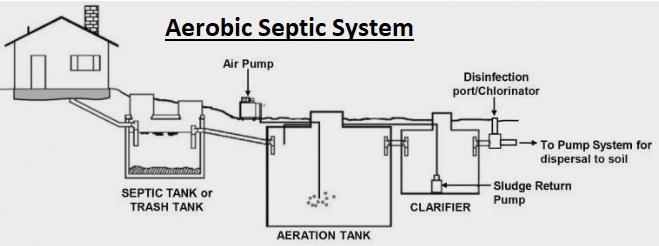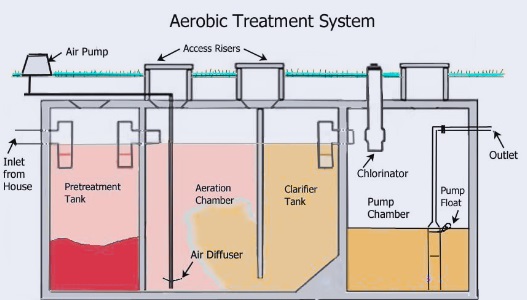An aerobic septic system is a wastewater treatment system that operates with aerobic microbes to effectively break down waste compared to a traditional septic system. This system comes with a trash tank for the separation of initial water. After that, aerobic treatment is performed in the unit, where an aerator circulates oxygen for microbial support.
In this post we will cover details for the aerobic septic system and its working and features.
What is an aerobic septic system?
- The ATS, or aerobic treatment system, also called an aerobic septic system, is a small-level sewage treatment system like a septic tank system that uses an aerobic process for digestion as compared to the anaerobic process used in a septic system.
- This system is commonly used for rural areas that do not have a public sewer system and is also used for single residences or small-sized homes.
- As compared to a conventional septic system, an aerobic treatment system produces high-quality secondary effluent that has sterilization features also used for irrigation.
- Its main features are that it is used in homes having smaller lots, improper soil conditions, and locations where the water table is high, and also at homes close to surface water bodies sensitive to contamination with nutrients in wastewater effluent.
Aerobic Septic System Working
The ATS process involved some process steps that are explained here.
Pretreatment
- In this step of the phases, larger solids and other material particles are removed.
Aeration stage
- In this phase aerobic bacteria digest biological wastes.
Settling stage
- In this phase, undigested solids settle. That makes sludge that is periodically removed from the system.
Disinfecting stage,
- In this step chlorine or other disinfectants are mixed with water to produce an antiseptic solution. UV disinfection is also used where water is exposed to UV light in a UV disinfection unit.
The disinfecting phase is optional and used for sterile effluent requirements, like conditions where effluent is applied over the ground.
The disinfectant used is calcium hypochlorite, which is used for the waste treatment system. The tablets are easily broken down in sunlight. Stabilized types of chlorine stay after effluent dispersion and have features to kill plants in the leach field.
ATS comes with a living ecosystem of microbes for digesting waste products in water; bulk existence of bleach has a bad effect on ATS environments and also reduces treatment working.
Components of an Aerobic Treatment Unit
The aerobic treatment process comes with 4 main parts that operate with each other for water purification.
Pretreatment tank:
- It is also called a trash tank since it removes materials that are not minimized through microbes.
Aeration chamber
- In this chamber, microbes decompose water in water. The aeration system comes with an air pump, piping, and diffusers that send air into aeration chambers. The air pump exists close to the aeration tank that compresses air into the aeration chamber.
- The diffuser applies force to air into water, dividing the air into bubbles that float on the surface.
Settling chamber,
- It is also called a clarifier that has an area for microorganisms that treat wastewater for water clearance.
Land application system
- It distributes wastewater into the soil from the final treatment and reuses it. Aerobic treatment units disperse wastewater through a spray distribution system that comes with disinfection that removes harmful microorganisms.
Benefits of Aerobic Septic Systems
Treatment Efficiency
- Oxygen and the production of aerobic bacteria increase the decomposition of organic materials. It provides more efficient treatment than a conventional septic system. That reduces septic tank pumping without affecting efficiency.
Environmental Impact
- The aerobic system generates effluent that is clean and has a low effect on the environment. The good treatment process minimizes the groundwater contamination and surface water pollution. There is a need for professional inspection to solve the error.
Installation
- The aerobic system has features to install in different soil categories, also for poor drainage. That makes them good and useful for locations where older septic systems do not work well.
What are conventional systems?
- In this system, solid wastewater is added in the septic tank, and it settles at the lower part. With time, that converted into sludge. Liquid waste that settles in the septic moves to the top.
- Add small buddies, anaerobic microbes that are in the tank. These small materials break down liquid and solid waste in the process of generating wastewater.
- In simple words, the working of a conventional septic tank is done. Now, direct wastewater towards the drainage field that exists at the start, with proper precautions.
- Make sure that the soil is permeable, which means wastewater does not seep to the water tables and stop this wastewater absorption.
Types of Aerobic Treatment Systems
Fixed film systems
- In this type of system, a porous medium is used that makes a bed for a biomass film that digests water materials in wastewater. There are different design configurations used for this system, but two are common.
- • The first one is where media move with wastewater, with putting film and exposing it to air, and the 2nd is static media use, and it changes the wastewater movement, and as a result, the film is submerged and exposed to air.
- In these two types, biomass faces wastewater and air used for aerobic digestion. Film is made with any porous material, like plastic or peat moss.
- In a basic system, static media is used and based on intermittent gravity operating wastewater flow for providing exposure to air and wastewater.
- The normal moveable media system is a rotating biological contactor that operates with disks rotating on a horizontal shaft. e disks are submerged at any given time, and the shaft rotates at a rate of one or two revolutions per minute.
Continuous flow, suspended growth aerobic systems
- This type of system has features to handle continuous flow and not have a bed for bacterial film, but bacteria are suspended in wastewater.
- The suspension and aeration are given with an air pump that pumps air through the aeration chamber to provide wastewater stirring.
- Some media for promoting fixed film bacterial production are used for handling high biomass in wastewater.
Retrofit or portable aerobic systems
- It is the remediation of a failed anaerobic septic system through retrofitting of an existing system having aerobic parameters.
- This type of product, also called aerobic remediation, is made for remediating biologically affected anaerobic distribution systems through reducing biochemical oxygen demand and total suspended solids of the effluent.
- Bio mat development is reversed through the reduction of BOD5 and TSS.
Composting toilets
- This system treats just toilet waste, as compared to other residential wastewater, and is used with water-free toilets, as compared to flush toilets.
- This system handles moist solid waste, not liquid suspension, and it separates urine-type feces at the time of treatment for maintaining accurate moisture in the system.
- Clivus multum is a basic type of composting toilet that comes with an inclined chamber that separates urine and feces for positive ventilation and to avoid smells in the toilet.
- IN chamber during and feces are broken with aerobic bacteria for this purpose. Fungi, arthropods, and earthworms also work.
Aerobic Septic System Maintenance
Add chlorine in the tank.
- It can be easily done; for this purpose, check the manufacturer’s manual for details on adding the amount of chlorine in the tank. Do not use pool chlorine since it does not clean wastewater. But it has a bad effect on vegetation.
- For adding chlorine, remove the lid of the aerobic septic system and add the recommended amount of chlorine, then close the lid.

